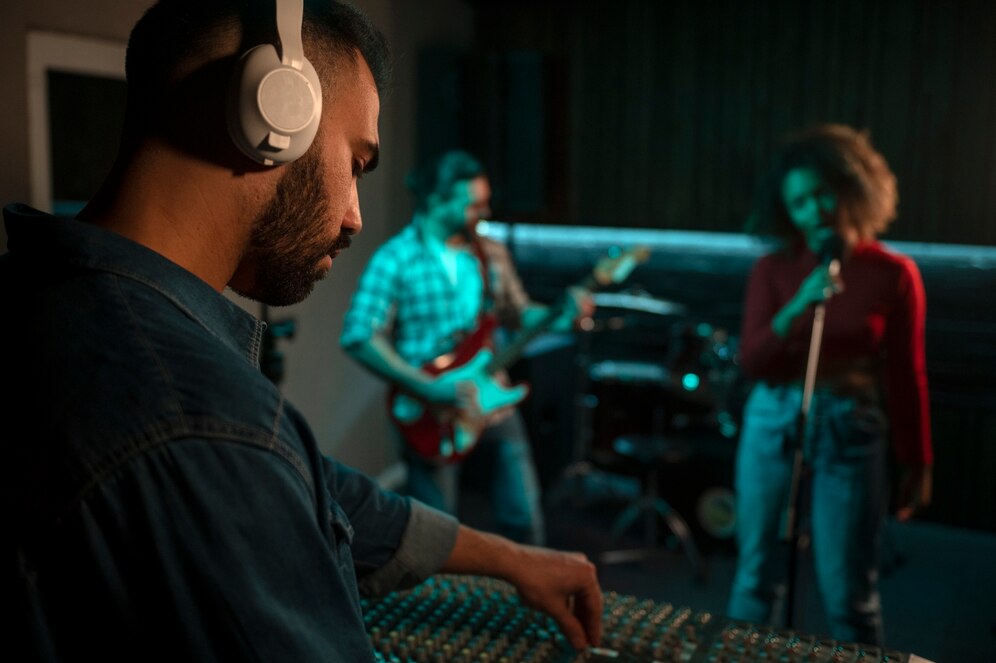
Imagine this: You’ve just finished recording your first song. The melody is catchy, the lyrics hit all the right emotional notes, and you’re buzzing with excitement to share it with the world. But when you play it back, something’s off. The vocals are drowned out by the guitar, the drums sound like they’re in a different room, and the whole thing feels flat. Sound familiar? That’s where mixing and mastering come in—two essential skills that can transform your raw recordings into polished, professional tracks. I’ve been there, fumbling through my first mixes, and I’m here to guide you through the process with a beginner-friendly roadmap that’s equal parts art and science.
Mixing and mastering might sound intimidating, but they’re really about balance and enhancement. Mixing is like cooking a meal—blending ingredients (your tracks) so every flavor shines without overpowering the others. Mastering is the final seasoning, giving your dish that restaurant-quality polish. Whether you’re a bedroom producer or an aspiring audio engineer, this guide will walk you through every step, from setting up your space to exporting your final track. Let’s dive in and turn your sonic chaos into a masterpiece.
Why Mixing and Mastering Matter
Before we get our hands dirty, let’s talk about why these skills are worth your time. A great mix can make a decent song unforgettable, while a bad mix can bury even the best performance. I remember my first attempt at recording—a lo-fi acoustic track I poured my heart into. I thought the raw take was enough, but when I shared it with a friend, they winced and said, “It’s got potential, but it sounds like mush.” Ouch. That’s when I realized mixing isn’t just technical—it’s about respecting your music and your listeners.
Mastering, on the other hand, ensures your track sounds good everywhere: phone speakers, car stereos, or high-end headphones. It’s the difference between a song that gets skipped and one that lands on repeat. According to Sound on Sound, a leading audio production magazine, mixing and mastering bridge the gap between creativity and technical precision. So, let’s start with the basics and build from there.
Setting Up Your Space: The Foundation of a Good Mix
You don’t need a fancy studio to mix and master—trust me, I started in a cramped apartment with a secondhand laptop and cheap earbuds. But your environment and tools do matter. First, let’s talk about your listening setup. If you’re using regular consumer headphones, you might miss subtle details because they often boost bass or treble to sound “fun” rather than accurate. Invest in a pair of studio monitors or flat-response headphones like the Audio-Technica ATH-M50x. They’re affordable and give you a truer picture of your sound.
Next, consider your room. Hard surfaces like walls and desks reflect sound, creating echoes that mess with your perception. My early mixes were boomy because I didn’t realize my tiny bedroom was acting like a reverb chamber. A quick fix? Hang blankets or foam panels to dampen reflections. You can grab acoustic foam from Amazon for cheap, or DIY with household items. Finally, grab a digital audio workstation (DAW)—Reaper is a budget-friendly option with pro-level features, perfect for beginners.
Understanding Your Ingredients: Tracks and Stems
Think of your song as a puzzle, with each piece (instrument, vocal, drum hit) needing to fit just right. These pieces are your tracks or stems—individual audio files you’ll blend together. Before mixing, listen to each one soloed. Is the guitar too muddy? Are the vocals clipping? I once spent hours mixing a track only to realize the snare was distorted from the start. Lesson learned: Fix issues at the source.
Organize your DAW with color-coded tracks—drums in red, vocals in blue, etc.—to keep things tidy. Label everything clearly, like “Lead Vox” or “Kick Drum,” so you’re not guessing later. This prep work saves headaches and lets you focus on the creative stuff.
Mixing 101: Crafting the Perfect Balance
Volume: The Unsung Hero
Mixing starts with volume. Set each track’s fader so nothing’s overpowering. A good rule of thumb is to keep your loudest element—like vocals or kick drum—peaking around -6 dB on your master meter. This leaves “headroom” to avoid distortion. I used to crank everything to max, thinking louder was better, until a mentor pointed out that quiet elements can still cut through with proper EQ.
Panning: Creating Space
Panning is your secret weapon for width. Imagine your mix as a stage: Drums and bass often stay center, while guitars or synths can drift left or right. I love panning backing vocals slightly off-center—it’s like they’re whispering in your ears. Play with stereo placement, but keep it natural—overdoing it can feel gimmicky.
EQ: Carving Out Clarity
Equalization (EQ) is where tracks stop fighting for attention. Each instrument has a frequency range it calls home—bass lives below 200 Hz, vocals shine around 1–4 kHz. Use a plugin like FabFilter Pro-Q 3 to cut overlapping frequencies. For example, if your kick drum sounds muddy next to the bass, reduce the kick’s low mids (around 300 Hz). It’s like giving each player their own spotlight.
Compression: Taming Dynamics
Compression evens out volume spikes, making tracks sit nicely together. Picture a vocalist who belts one line and whispers the next—compression smooths that out. Start with a 4:1 ratio and adjust the threshold until it feels controlled but not squashed. My first mixes were lifeless because I overcompressed everything—less is often more.
Reverb and Effects: Adding Depth
Reverb gives your mix a sense of space, like recording in a cathedral versus a closet. Add a touch to vocals or snares, but don’t drown them—too much reverb turns clarity into soup. Delay or chorus can spice things up too. Experiment, but always ask: Does this serve the song?
Mastering: The Final Polish
Once your mix sounds balanced, it’s time to master. Mastering preps your track for the world, ensuring consistency and loudness. I used to skip this step, thinking my mix was “done,” but unmastered tracks sounded weak next to commercial releases.
EQ and Compression (Again)
In mastering, EQ fine-tunes the overall tone. Boost the highs slightly for sparkle or cut muddiness below 50 Hz. Compression here is subtle—use a low ratio (1.5:1) to glue the mix together. Check out Ozone by iZotope for beginner-friendly mastering tools.
Limiting: Loudness Without Distortion
A limiter sets your track’s maximum volume, matching the loudness of pro songs (around -1 dB true peak). Be careful—pushing too hard introduces clipping. I once ruined a mix by over-limiting, turning it into a wall of noise. Aim for clarity over sheer volume.
Exporting: The Finish Line
Export your master as a 16-bit, 44.1 kHz WAV file for most platforms like Spotify. Listen on multiple devices—your car, phone, earbuds—to catch flaws. My first mastered track sounded great on headphones but tinny on my laptop. Adjust and re-export if needed.
Comparison Table: Mixing vs. Mastering
| Aspect | Mixing | Mastering |
|---|---|---|
| Goal | Balance individual tracks | Polish the final mix |
| Tools | EQ, compression, panning, effects | EQ, compression, limiting |
| Focus | Clarity and separation | Loudness and consistency |
| Stage | During production | After mixing |
| Analogy | Cooking the meal | Plating and presentation |
This table sums up the vibe: Mixing builds the house; mastering paints it and adds the furniture.
Common Pitfalls and How to Avoid Them
- Overprocessing: Too many effects can muddy your mix. Solo tracks to hear what’s essential.
- Ignoring Reference Tracks: Compare your work to pro songs in your genre. I use Spotify playlists to benchmark my mixes.
- Mixing at High Volumes: Loud levels trick your ears into loving everything. Mix at moderate levels (around 70 dB) to stay objective.
- Skipping Breaks: Fatigue kills judgment. Step away for an hour—your ears will thank you.
FAQ: Your Burning Questions Answered
What’s the difference between mixing and mastering?
Mixing balances individual tracks into a cohesive whole, while mastering enhances that final stereo file for distribution. Think of mixing as sculpting and mastering as polishing.
Do I need expensive gear to start?
Nope! A decent DAW, headphones, and a quiet space are enough. Skills trump gear every time—check out Gearslutz forums for budget tips.
How long does it take to mix a song?
For beginners, 5–10 hours is normal. Pros might take 2–3 hours once they’ve honed their workflow. Practice speeds you up.
Can I master my own tracks?
Yes, but it’s tricky to stay objective. If possible, get a second pair of ears—or use tools like LANDR for automated mastering as a starting point.
Why does my mix sound different on other speakers?
Room acoustics and playback systems vary. Test on multiple devices and consider room treatment to minimize surprises.
Conclusion: Your Sonic Adventure Begins
Mixing and mastering are a journey, not a race. My first polished track took weeks, countless YouTube tutorials, and a lot of trial and error—but when I finally nailed it, the satisfaction was unreal. You’re not just tweaking knobs; you’re shaping how people experience your music. Start small: Mix a simple acoustic track, master it, and share it with a friend. Listen to their feedback, tweak again, and keep going.
The beauty of this craft is its blend of creativity and logic. Every knob twist is a choice, every adjustment a story. Dive into your DAW, experiment fearlessly, and trust your ears—they’ll grow sharper with time. Want to dig deeper? Explore resources like Mixing Secrets for the Small Studio by Mike Senior or join online communities like Reddit’s r/audioengineering. Your next track could be the one that turns heads—so what are you waiting for? Grab those headphones, fire up your DAW, and let’s make some noise.

